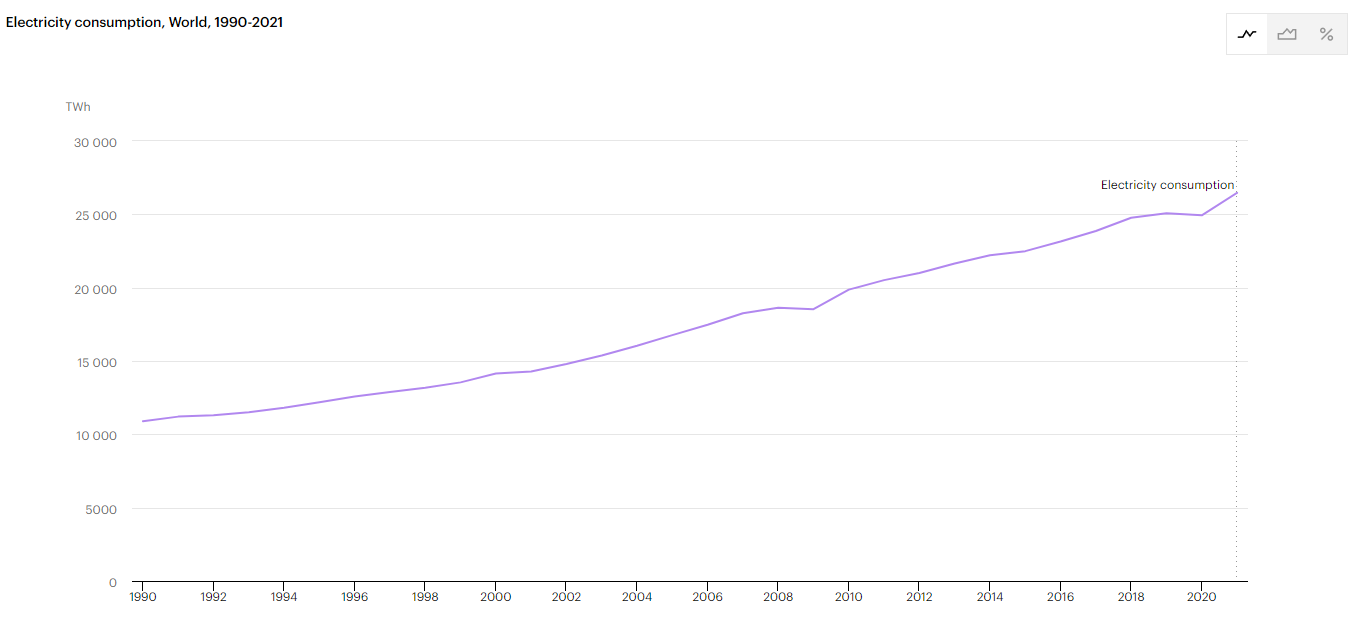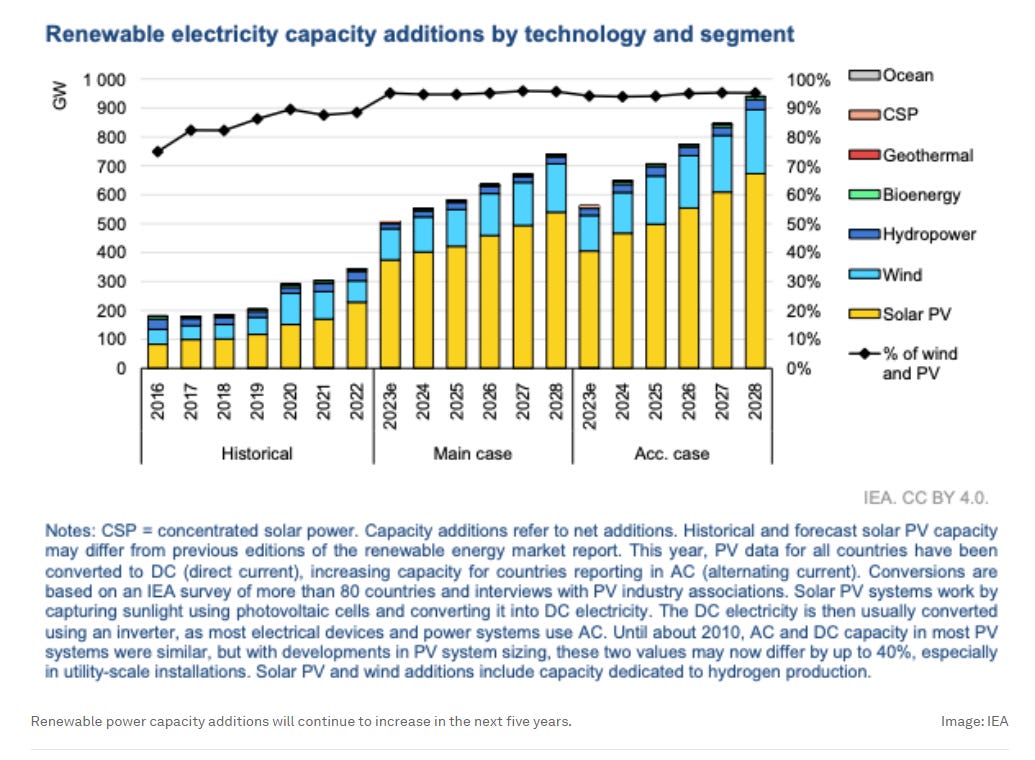How much land would it take to power the world using clean energy sources, and infographic of the week (IOTW)
The Answer is <4%!!!
Follow my page on TikTok, and Instagram.
The increasing demand for energy in the modern world has prompted a shift towards renewable energy sources, aiming to reduce our dependency on fossil fuels and mitigate the effects of climate change. Solar, wind, and nuclear power have become some of the most mature, viable, and scalable solutions.
One of the key considerations when discussing these energy sources is land use: how much space is required to generate enough energy to power the entire planet?
The Global Energy Demand
Before delving into the specifics of each energy source, it's important to understand the global energy demand. According to the International Energy Agency, in 2021, the global energy consumption was approximately 25,000 terawatt-hours (TWh). This energy consumption includes electricity generation, transportation, industrial processes, and heating. To power the entire world using only renewable or low-carbon sources, it’s crucial to evaluate the energy density and efficiency of various methods of generation, as well as their spatial and environmental impact.
Source: International Energy Agency
Solar Energy: Land Use and Feasibility
Land Requirements for Solar Power
Assume each solar PV panel produces about 300 watts to 350 watts per square meter depending on geographical location and solar panel efficiency. According to the National Renewable Energy Labs (NREL);
A large fixed tilt solar PV plant that generates 1 gigawatt-hour (GWh) per year requires, on average, 2.8 acres for solar panels. This means that a solar plant that provides all the electricity for 1,000 homes would require 32 acres of land.
Small single-axis PV systems require on average 2.9 acres per annual GWh – or 3.8 acres when considering all unused area that falls inside the project boundary.
This means a solar plant generating 1 TWh annually would require approximately 2,800 acres (around 11.3 square kilometers).
In 2021, this would have meant that we would have needed ~70,000,000 acres or ~283,280 sq. km. Where can we find this?
Ecuador: About 283,561 square kilometers in size, Ecuador is located in South America and includes the Galápagos Islands.
Nevada, USA: With an area of 286,380 square kilometers, Nevada is one of the larger U.S. states, mostly covered by desert and mountainous regions.
Burkina Faso: This landlocked country in West Africa spans 272,967 square kilometers, slightly smaller but close to the target area.
New Zealand: New Zealand has an area of 268,838 square kilometers, including both the North and South Islands, slightly smaller than 283,280 square kilometers.
Rajasthan, India: Home to the only desert in the country, with a total area of 342,239 sq. km.
Obviously these figures assume that the project economics are always favorable and there are zero issues or delays tied to permitting for projects. In reality it is also true that housing all panels in one area is not practical and less than useful. However for illustrative purposes, we need <1% of the world’s land for solar PV panels.
Environmental and Social Impact of Solar Land Use
While 283,000 square kilometers is a significant amount of land, solar panels can be installed on rooftops, reducing the impact on land.
However, large solar farms do have potential downsides:
Ecosystem Disruption: Solar farms, especially in delicate ecosystems such as deserts, can disrupt wildlife habitats. For example, the construction of solar farms in desert regions has raised concerns about the displacement of species like desert tortoises.
Energy Storage and Transmission: Solar power generation is intermittent (due to night-time and weather conditions), so large-scale energy storage systems are needed to ensure a reliable power supply. The infrastructure required to store and transmit electricity over long distances can add to land-use requirements.
Handling of end-of-life (EOL) panels and recycling: Defective and most EOL panels are not recycled due to lack of available and existing infrastructure in several parts of the world. EOL panels in landfills is a real concern and an issue that requires urgent action and policy support to hold producers, installers, and users collectively accountable.
Wind Energy: Land Use and Feasibility
Land Requirements for Wind Power
Wind turbines can generate varying amounts of electricity based on their size and the wind speed in the area. A typical modern onshore wind turbine generates about 3-4 megawatts (MW) of power.
About 294 utility scale wind turbines (onshore) or about 103 offshore wind turbines generate 1 GW or 4 TWh, and occupy about 160 sq miles of land.
In 2021, the world would have needed 1 million sq miles or 2.6 million sq km of wind turbines to fulfill global consumption. Where can we find this?
Argentina: Argentina has an area of approximately 2.78 million square kilometers, making it the eighth-largest country in the world.
Kazakhstan: Kazakhstan's land area is 2.72 million square kilometers, slightly larger than 2.6 million square kilometers, and it is the largest landlocked country in the world.
Greenland: Greenland has an area of 2.17 million square kilometers, slightly smaller but within a close range.
Saudi Arabia: Covering 2.15 million square kilometers, Saudi Arabia is another country that's close to the 2.6 million square kilometer mark.
The Democratic Republic of the Congo (DRC): The DRC covers 2.34 million square kilometers, making it one of the largest countries in Africa.
Environmental and Social Impact of Wind Land Use
Wind turbines are often spread out over large areas, but the land between them can still be used for farming, agriculture, or grazing. Thus, the effective land footprint of wind farms can be smaller than the total area they cover.
However, wind energy also presents challenges:
Visual and Noise Pollution: Large wind turbines can be considered an eyesore and generate noise, which may lead to opposition from local communities.
Intermittency: Like solar energy, wind power is intermittent and requires energy storage solutions to ensure consistent energy supply.
Handling of end-of-life (EOL) turbines and blades: Recycling EOL turbines and blades pose similar challenges as EOL solar PV and in many cases more challenging than solar PV.
Nuclear Energy: Land Use and Feasibility
Land Requirements for Nuclear Power
Nuclear power plants are much more land-efficient than renewable sources. To power the entire world using only nuclear energy, approximately 17,000 square kilometers of land would be required, which is equivalent to the size of Kuwait.
Environmental and Social Impact of Nuclear Land Use
While nuclear power has a much smaller land footprint compared to solar and wind, it comes with its own set of challenges:
Radioactive Waste: The disposal of nuclear waste is a significant issue, as radioactive materials remain hazardous for thousands of years. Finding secure and long-term storage solutions is crucial.
Nuclear Accidents: Accidents like Chernobyl and Fukushima have raised concerns about the safety of nuclear power plants. While modern reactors are much safer, the risk of catastrophic failure remains a concern.
Water Usage: Nuclear reactors require large amounts of water for cooling, which can strain local water supplies, especially in arid regions.
Combined Renewable Energy Strategies
A realistic global energy strategy would likely involve a combination of renewable energy sources rather than relying solely on one. For example, solar energy can be deployed in sunny, arid regions; wind farms can be placed in coastal and windy areas; and nuclear power can be used to provide reliable base-load electricity. Although renewable energy has a smaller environmental impact than fossil fuels, land use conflicts may arise, particularly in densely populated regions. Innovative approaches such as agrivoltaics (combining solar panels with agriculture) can help mitigate these conflicts.
Infographic of the week - Renewable electricity capacity additions, globally
According to the World Economic Forum Annual Meeting in 2024;
“The world added 50% more renewable capacity in 2023 compared to the previous year.
The COP28 climate talks called for a tripling of renewable energy capacity and doubling energy efficiency improvements by 2030.”





![Recycling: A Solar Panels Life after Death [infographic] Recycling: A Solar Panels Life after Death [infographic]](https://substackcdn.com/image/fetch/$s_!gUDl!,w_1456,c_limit,f_auto,q_auto:good,fl_progressive:steep/https%3A%2F%2Fsubstack-post-media.s3.amazonaws.com%2Fpublic%2Fimages%2F91e5a881-1fac-4334-bcb8-27cc10451c2e_770x3847.png)

